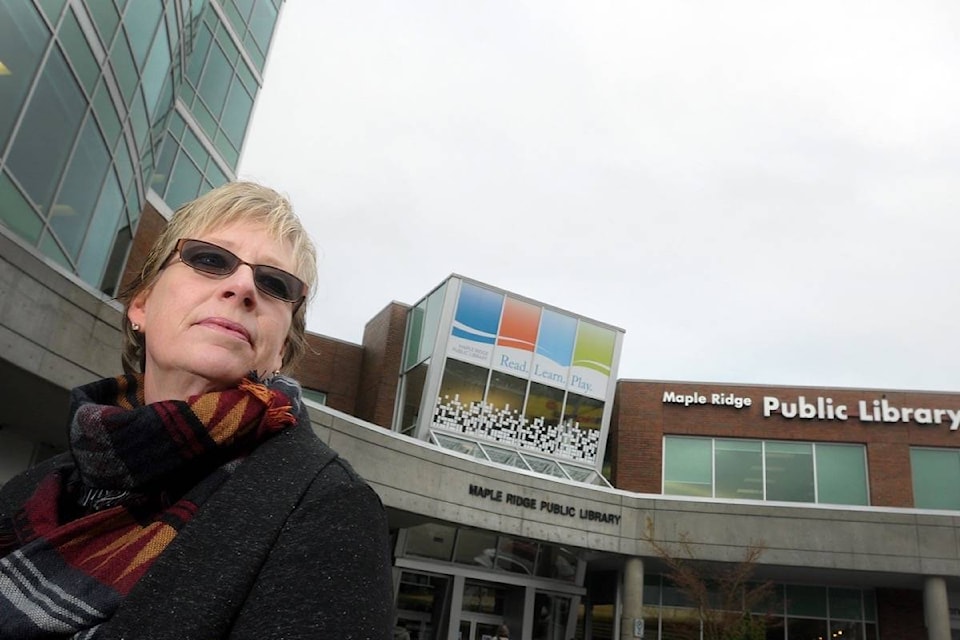Local library staff are not to administer naloxone, even if trained to do so and in possession of it, to a patron suspected of overdosing on drugs, such as opioids.
The current policy for staff at the Maple Ridge and Pitt Meadows branches of the public library is to call 911 and stand clear.
But that doesn’t sit well with Susan Carr, a school trustee who chairs the city’s social policy advisory committee, served on the Strong Kids Team, and organized two forums on fentanyl.
She thinks library staff should be allowed to administer naloxone, a drug that reverses the effects of an opioid overdose.
“A responsible community should have their staff trained in first-aid. Whether that’s library, rec centre, pool, they all should be trained,” said Carr.
A record 1,422 people in B.C. died of an illicit drug overdose in 2017. The Fraser Health Authority had the highest number of those deaths at 473. Maple Ridge had 33, the 10th highest of those in the coroner’s report.
Scott Hargrove, CEO of the Fraser Valley Regional District Library, said part of the concern is staff safety, such as accidental contact with fentanyl, or administering naloxone to someone who didn’t require it.
“I think that’s one of the things we were concerned about, making sure that well meaning staff might leap into it. Find somebody who was sleeping or something similar. We just don’t know what the training side of it would be required to make that safe,” said Hargrove.
“So for this point, we have said don’t use naloxone kits, just call 9-1-1- and then stand back,” he said.
The policy has been in place for the past six months and Hargrove said everyone from police, fire, paramedics and legal council were consulted between July and September last year, when the opioid crisis was starting to get worse.
In addition, Hargrove says, many of the libraries are located close to first responders.
“We certainly have found police or fire or paramedics, any of which can deal with the situation, arrive very quickly,” he said.
“Part of the advice we had came from the ministry of labour. We talked to them, our legal council basically said, ‘Look, you’re a library, your job is to be a library, the job of first responders like police, fire and ambulances is to do exactly what you are talking about, help people in an overdose situation,” he explained.
The policy also extends to administering CPR.
“I can tell you when we were doing this research, part of our research was to call all the libraries around us and confirm what they were doing and why,” said Hargrove, confirming that its policy is consistent [with] that of the Vancouver Public Library.
There are no naloxone kits on site at any of the libraries in the Fraser Valley Regional District.
Last year, Hargrove said, there were 17 “drug or alcohol substance suspected events” reported in the Maple Ridge Public Library.
“Now that could be something as simple as somebody having alcohol on their breath. There was no indication in there that I could see of any confirmed overdoses,” he said, adding that there was one case where somebody found a needle in the bathroom.
Hargrove said some libraries have seen an increase in the number of drug and alcohol related abuse incidents, including Maple Ridge.
“We’ve seen an increase, but we haven’t seen something which would really require us to have an army of people trained, nothing like that,” he said.
So far this year, there have been seven drug related incidents in the Maple Ridge library. Three involved drug paraphernalia being found, including needles in a coat pocket.
The public library does have procedures and kits for picking up suspicious items. There are puncture resistant gloves, tongs and safe disposal containers. A safe disposal company disposes of the sharps.
Another time a man fell over by the public Internet stations. Another person was found sleeping.
In two other cases, patrons were suspected or admitted to using drugs at the library and they were asked to leave.
Once, a person was banned from the library for a certain period of time.
Hargrove said from the two cases where medical calls were made for potential drug interactions, “it falls short of what we would think of as an overdose, where somebody is comatose and unresponsive requiring Narcan,” the brand name of naloxone.
“We’re watching it cautiously. We are constantly looking at the situation around us,” said Hargrove.
Maple Ridge Fire Chief Howard Exner said the fire department responded to a call at the library for an overdose once each in 2016 and 2015.
Carr said administering naloxone to somebody who is in distress should be part of an overall first-aid plan.
“Much like what I am advocating for in schools. It’s not separate. It’s part of a first-aid plan that you already have.”
Carr believes that not having a plan to include naloxone further stigmatizes drug users, especially given the current campaign by the B.C. government on overdose prevention and response.
She said using naloxone is a “no brainer” once you are trained. Also part of the training is what symptoms to look for to recognize when somebody is overdosing.
She said that can be helpful information to a 9-1-1 operator, who can help walk people through steps to administer naloxone.
“Embrace it, welcome it in, make it part of a first-aid plan and it’s not such a big deal.”
Jacqueline Blackwell, with Fraser Health, said a person can be trained to administer naloxone in as little as five minutes.
“If a person is unfamiliar with administering medications by injection, the process may take a little longer,” she added.
“There are no health concerns associated with incorrectly administering naloxone.”
